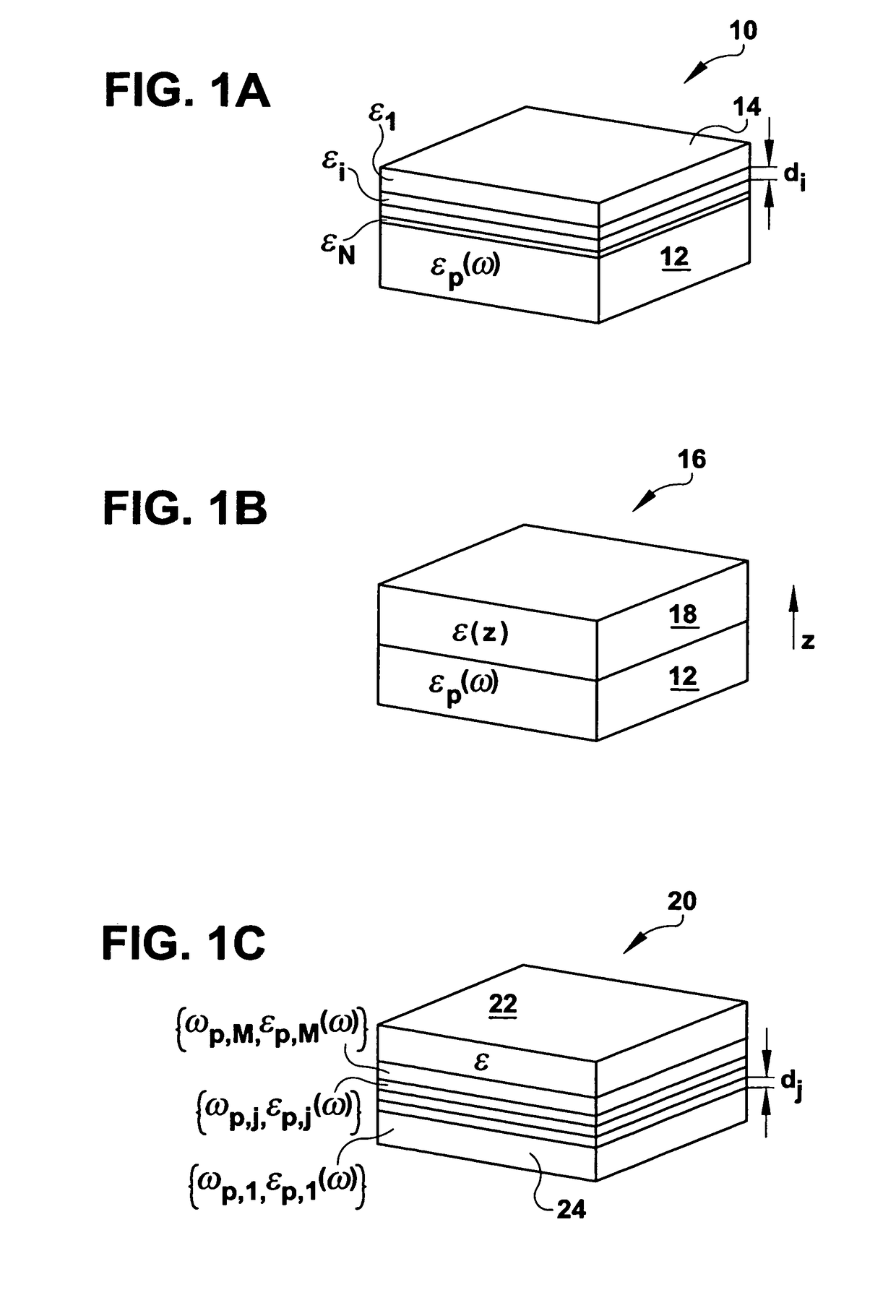Surface-PlasmonoDielectric-polaritonic devices and systems
a surface-plasmonodielectric-polaritonic and device technology, applied in the direction of optical waveguide light guide, light demodulation, instruments, etc., can solve the problems of system bandwidth delay product, non-ideal wavepacket propagation, and limit the achievable, so as to achieve superior system performance and extend the effect of capabilities
- Summary
- Abstract
- Description
- Claims
- Application Information
AI Technical Summary
Benefits of technology
Problems solved by technology
Method used
Image
Examples
example i
[0112]An SPDP structure having a layered dielectric region adjacent to a homogeneous plasmonic material region, as in FIG. 1A, was designed. The dispersion relation engineering method described above was employed to determine a dispersion relation for the SPDP structure so that the diagram of the frequency-wavevector correspondence specifically resembled the letters “MIT.”FIG. 5A is a plot of this diagram of frequency as a function of wavevector, here both normalized to the plasmonic values.
[0113]To achieve this dispersion relation, the SPDP structure was defined with the permittivity surrounding the structure set as ε=1 and the plasmonic high-frequency permittivity set as ε∞=1. It was found that nine dielectric layers were required to achieve this dispersion relation. From the top to the bottom of the stack of nine dielectric layers, the permittivities were given as εi={4, 1, 10, 1, 10, 1.7, 1, 10, 1.7}. The thicknesses of the nine dielectric layers, from the top to the bottom of t...
example ii
[0115]An SPDP structure having a layered dielectric region adjacent to a homogeneous plasmonic material region, as in FIG. 1A, was designed as in Example I, and the dispersion relation engineering method described above was employed to determine a dispersion relation for the SPDP structure so that dispersion would be substantially suppressed to a high-order. The dispersion relation was further specified for a positive group velocity. FIG. 6A illustrates the resulting dispersion diagram, plotted as frequency as a function of wavevector, here both normalized to the plasmonic values.
[0116]To achieve this dispersion relation, the SPDP structure was defined with the permittivity surrounding the structure set as ε=1 and the plasmonic high-frequency permittivity set as ε∞=1. It was found that four dielectric layers were required to achieve this dispersion relation. From the top to the bottom of the stack of four dielectric layers, the permittivities were given as εi={4, 1, 4, 1}. The thick...
example iii
[0119]An SPDP structure having a layered dielectric region adjacent to a homogeneous plasmonic material region, as in FIG. 1A, was designed as in Example I, and the dispersion relation engineering method described above was employed to determine a dispersion relation for the SPDP structure so that dispersion would be substantially suppressed to a high-order. The dispersion relation was further specified for a negative group velocity. FIG. 7A illustrates the resulting dispersion diagram, plotted as frequency as a function of wavevector, here both normalized to the plasmonic values.
[0120]To achieve this dispersion relation, the SPDP structure was defined with the permittivity surrounding the structure set as ε=1 and the plasmonic high-frequency permittivity set as ε∞=1. It was found that five dielectric layers were required to achieve this dispersion relation. From the top to the bottom of the stack of five dielectric layers, the permittivities were given as εi={4, 1, 4, 1, 4}. The th...
PUM
| Property | Measurement | Unit |
|---|---|---|
| surface plasmon polaritons | aaaaa | aaaaa |
| dielectric permittivity | aaaaa | aaaaa |
| metallic | aaaaa | aaaaa |
Abstract
Description
Claims
Application Information
 Login to View More
Login to View More - R&D
- Intellectual Property
- Life Sciences
- Materials
- Tech Scout
- Unparalleled Data Quality
- Higher Quality Content
- 60% Fewer Hallucinations
Browse by: Latest US Patents, China's latest patents, Technical Efficacy Thesaurus, Application Domain, Technology Topic, Popular Technical Reports.
© 2025 PatSnap. All rights reserved.Legal|Privacy policy|Modern Slavery Act Transparency Statement|Sitemap|About US| Contact US: help@patsnap.com



